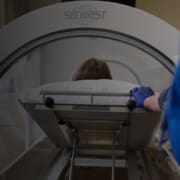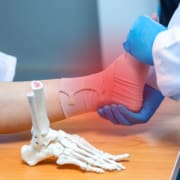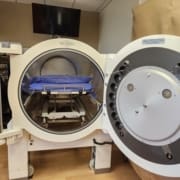Hyperbaric Oxygen Therapy for the Treatment of Chronic Pain
Hyperbaric oxygen therapy has been around since the 1600s but was heavily used in the early 1900s, primarily for deep-sea divers suffering from decompression sickness. It then evolved into aiding multiple breathing ailments, even treating certain types of bone disease.
This type of therapy, also known as HBOT, should only be prescribed by a medical professional. Certain hospitals will contain the chambers used for HBOT.
There are two different types of chambers: monoplace and multiplace chambers. The monoplace’s design is meant for one person to sit inside, similar to an MRI machine, while the multiplace chamber has the capability to treat multiple patients simultaneously.
Once inside, the patient can sit or lie down. While remaining relaxed, they then breathe in and out deeply, which will continue from around 45 minutes to about five hours.
During these sessions, the treatment will begin helping repair injured tissues that are oxygen deprived. As the treatment involves an excess of oxygen being sent throughout the body, it is common for patients to feel pressure in their ears, similar to being inside an airplane. Swallowing or yawning can help relieve this pressure. Once completed, the individual may feel lightheaded or fatigued and may develop a headache.
HBOT has the potential to treat several different ailments, such as:
- Carbon monoxide poisoning
- Cyanide poisoning
- Crush injuries
- A form of gangrene known as gas gangrene
- Decompression sickness
- Decreased blood flow in the arteries
- Complications with skin grafts,
- Infection of the bone, delayed radiation injury
- Air bubble trapped in a blood vessel
- Flesh-eating disease
- Chronic infection
- Diabetic wounds.
Above all, HBOT has been proven as an effective treatment for chronic illnesses.
The Use of Hyperbaric Oxygen in Chronic Pain Syndrome
Many adults who suffer from chronic pain are looking for an effective way to relieve the pain. Unfortunately, chronic pain is not easy to cure. In many instances, it is not possible to cure permanently.
Hyperbaric oxygen has been used to treat those with chronic pain with promising results. Studies conducted on animals have shown that there is an analgesic effect as a result of this type of therapy.
For those with chronic external wounds, hyperbaric oxygen treatment will deliver oxygen-rich plasma to the tissues in the body that are deprived of oxygen. This is necessary as the wound swells, causing the tissues to die. HBOT prevents swelling, allowing oxygen to revive the dying tissue.
For extensive tissue damage, when healing slows or stops due to a crush injury, HBOT allows oxygen radical scavengers to prevent more harmful radicals from being released. This treatment can also block bacteria from entering the body, allowing the immune system to strengthen and white blood cells to focus on attacking intrusive cells. It can also assist with new blood vessel growth, allowing collagen and new skin cells to develop.
This therapy aims to accelerate recovery time, which it achieves by increasing ATP production.
Other chronic ailments, such as Lyme disease, can potentially benefit from HBOT therapy. Since Lyme disease thrives on low oxygen levels, HBOT is effective in fighting against it as it provides an increase of oxygen to the body.
Another type of chronic pain that can benefit from HBOT is chronic back pain. For all chronic ailments, the treatment and the benefits of receiving treatment are the same.
The Major Benefits of Hyperbaric Therapy
The number one benefit of receiving this treatment is a faster recovery time.
Increased circulation is another significant benefit. With increased circulation, toxins leave the body while oxygen and mineral levels increase.
This treatment can also help reduce inflammation, one of the main reasons why wounds or chronic illnesses do not heal or take longer to heal. Patients may also experience increased blood flow, which is extremely beneficial to those with diabetes.
Another benefit of hyperbaric therapy is increased collagen production, crucial to creating new skin, connective tissue, and blood vessels. It can also strengthen the immune system, as white blood cells are more functional.
In addition, patients can sometimes enjoy anti-aging benefits through HBOT, as it helps restore and renew the body’s cells.
With such a wide range of physical benefits, hyperbaric oxygen therapy is a highly advantageous treatment option for numerous conditions. While everyone reacts differently to treatments, patients will surely enjoy at least one of the many benefits of HBOT.
Clinical Effectiveness of HBOT
Currently, HBOT is typically the most effective for those suffering chronic pain due to headaches, fibromyalgia, or complex regional pain syndrome. An independent research agency, CADTH, conducted a study to discover the effectiveness of HBOT for those with fibromyalgia.
The study included giving the HBOT treatment over the course of five days each week for a total of two months. The results concluded that a higher tolerance for pain was achieved for these participants, lower stress, as well as an overall higher quality of life.
One study involved a 41-year-old who suffered from constant pain in his foot. After being treated with HBOT, he was able to experience lasting pain relief, allowing him to return to work and enjoy daily life once more.
Another study included participants struggling with myofascial pain syndrome that was given the HBOT treatment over the course of two weeks, five days per week. The results were similar to the previous study in that they obtained a higher tolerance for pain and a better quality of life. Participants declared that these results lasted for about three months.
Research isn’t conclusive on the long-term effectiveness of hyperbaric oxygen therapy. While these studies mentioned have positive results, there is not enough research to confirm whether this type of therapy is long-lasting. However, the results of these studies are promising, especially for those suffering from ailments related to chronic pain, and deserve further investigation.
Quantity of Research Available on Hyperbaric Therapy
Researchers are still conducting studies in this area. Most include the long-term improvements of the patients experiencing fatigue, sleeping habits, and tender points. However, limited studies may exist due to the low number of randomized control groups. Because of this, results may be insufficient or inconclusive.
While this treatment may benefit those struggling with chronic pain and fatigue, insomnia, and tender points, we need further research.
A Review of Cost-Effectiveness of Using Hyperbaric Therapy
Chronic illness is difficult to live with; therefore, an individual can spend lots of money trying to find treatment with long-lasting results. Over-the-counter medications may offer temporary relief. Surgeries may also offer temporary relief, depending on the condition, if surgery is an option.
While over-the-counter medication is not always expensive, it can still be costly to the person, as they will continually need to purchase it. Surgeries, if an option for their condition, are also expensive.
However, using HBOT may be cost-effective for the patient if they are able to have longer-lasting results. It is also a non-invasive option for those who prefer to avoid surgery.
For those looking for HBOT treatment, remember that Medicare, Medicaid, and many insurance companies cover it. However, coverage can depend on why the individual is requesting this treatment. Before undergoing this therapy, check with your provider.
Limitations of Using Hyperbaric Therapy
Although there are many benefits for those who use HBOT, it is not recommended for everyone. Those who have had surgery on the ear, have a cold, or those with lung disease should not use this therapy.
In addition, those considering this treatment should understand that the changes in the atmospheric pressure experienced when in the chamber tend to affect patients. It is also important to note that this treatment is unavailable in all areas of the country.
As with any medical treatment, risks and complications are involved– the most common being issues to the ear. Other issues that can result are damage to the eye, decreased blood sugar levels, sinus issues, and even lung collapse. Rare cases have also reported oxygen poisoning.
If you are suffering from a chronic illness or chronic pain, looking into hyperbaric therapy may be a good option for you. While this therapy can treat many ailments, keep in mind that the results may be temporary, or it may not even be an option for you, depending on your location.
In most circumstances, patients achieved pain relief, which continued for at least three months. Remember, as you are researching treatment, why you are seeking this treatment may affect coverage. Understand the pros and cons and speak with your insurance provider on treatment coverage.
Additional Read: HBOT for Chronic Pain from Bowel Dysfunction
Contact NexGen Hyperbaric LLC to Learn More About HBOT for Chronic Pain
Are you seeking more information to decide whether or not HBOT is for you? Contact us at NexGen Hyperbaric to learn more by calling (888) 567-4302.










